Trashcanman
Harmless

Posts: 20
Registered: 23-1-2024
Member Is Offline
|
|
GLMITE - WW2 superexplosive or crackpot idea
During WW2 a bomb developer named Lester P. Barlow claimed to have discovered a new type of explosive utilizing liquid oxygen which would surpass
every other explosive in use at the time.
He dubbed this explosive "GLMITE".
Personally I think that there is no way that a mixture of liquid oxygen with another substance can be much better than TNT but Barlow managed to
convince some influential people to give him the clearance to conduct tests with GLMITE.
The biggest test with several hundred pounds of his explosive failed to kill any of the 200+ goats that were tethered at different distances from the
explosion.
I uploaded several newspaper articles and other documents that I found on the internet regarding "Barlow's bomb" to Archive.org.
BarlowBombCompendium
This could be the end of this post but there are some important questions that I think need to be answered.
Why was Barlow so sure that GLMITE would have a more severe effect than other explosives i.e. what was the theoretical foundation and if it was just a
scam then why did he try to conduct supervised tests?
Surely he must have known that if this was a scam that a test would reveal the truth and this would forever mark him as a fraud.
Some of the newspaper articles claim impressive results during the German bombing of Barcelona like bombs killing people located a quarter of a
mile(400 meters) from the explosion.
Is there any evidence of those alleged effects or were those claims nothing more but rumors combined with the fear that Germany developed a wonder
weapon with an enormous blast radius?
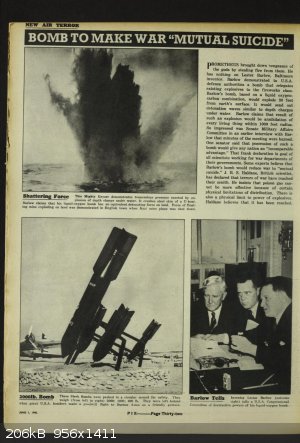
Attachment: GLMITE_BarlowBombExplosion.mp4 (981kB)
This file has been downloaded 41 times
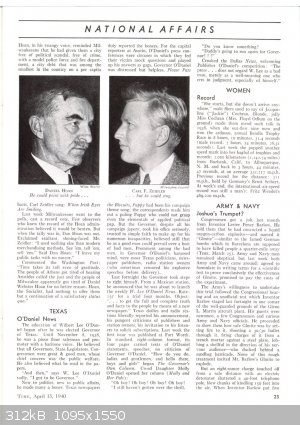
|
|
|
Etanol
Hazard to Others
  
Posts: 138
Registered: 27-2-2012
Member Is Offline
Mood: No Mood
|
|
Oxyliquits are high fougasse but low brisance explosives.
For a carbon-liquid oxygen mix, the heat of the explosion is about 8.8 MJ/kg, the max VOD is only about 6.5 km/s at 1.32 g/сс, the brisance and
throwing ability are at the level of nitroglycol.
|
|
|
Sir_Gawain
Hazard to Others
  
Posts: 273
Registered: 12-10-2022
Location: Due South of Due West
Member Is Offline
Mood: Yes.
|
|
Interesting that the concept of mutually assured destruction was around before nuclear weapons.
Anyway, I don’t think there’s any way for a simple fuel/oxidiser mixture to outperform molecularly bonded explosives.
“Alchemy is trying to turn things yellow; chemistry is trying to avoid things turning yellow.” -Tom deP.
|
|
|
digga
Harmless

Posts: 39
Registered: 11-6-2018
Member Is Offline
|
|
https://www.bedbathandbeyond.com/Home-Garden/The-Explosion-O...
|
|
|
EF2000
Hazard to Others
  
Posts: 111
Registered: 10-5-2023
Location: The Steppes, now trapped in the forest zone
Member Is Offline
Mood: wrooom
|
|
Quote: Originally posted by Trashcanman  |
Some of the newspaper articles claim impressive results during the German bombing of Barcelona like bombs killing people located a quarter of a
mile(400 meters) from the explosion.
Is there any evidence of those alleged effects or were those claims nothing more but rumors combined with the fear that Germany developed a wonder
weapon with an enormous blast radius? |
My guess those claims are combination of rumors, imprecise sensationalist reporting, atrocity propaganda from the Republican side, positive propaganda
(bluffing) from the Fascist side, and some amount of quite possible casualties from fragmentation.
Bombing of Barcelona was done by Italians, with only the first raid conducted by Germans (and that with He 51 biplanes capable of carrying 6 10 kg
SD10 fragmentation bombs at most).
All further raids on Barcelona were conducted by Italian medium bombers, S.M.79 and S.81, with maximum payloads of 1250 and 2000 kg (short-range,
generally 1000 kg). I guess that, for carpet bombing mission, a lot of small bombs would be used, like 12x or 28x of GP 50 50 kg bombs.
But if we assume that medium weight 250 kg bombs were used, reports of casualties at ~400 metres become more realistic. "Explosive weapon effects" report by GICHD says that "risk estimate distance" (RED) with 0.1% "expected percentage of incapacitation" for
500lb/250kg-class bomb is 425 metres (see Table 10 at p.84). REDs are calculated for soldiers lying prone, for standing unprepared civillians hit
probability and distances are more. Also in urban areas, there's a lot of secondary fragments like shattered glass.
Also should be noted that during one of air raids, a truck with explosives was hit, resulting in huge explosion and rumors about giant bombs,
according to "The battle for Spain" by Antony Beevor, page 333.
Thanks for reading an armchair analysis by a dummy.
Wroom wroom
|
|
|
DennyDevHE77
Hazard to Others
  
Posts: 148
Registered: 15-9-2014
Member Is Offline
Mood: No Mood
|
|
Quote: Originally posted by Sir_Gawain  | Interesting that the concept of mutually assured destruction was around before nuclear weapons.
Anyway, I don’t think there’s any way for a simple fuel/oxidiser mixture to outperform molecularly bonded explosives. |
They may not surpass it, but dense homogeneous mixtures can be on a par.
|
|
|
Trashcanman
Harmless

Posts: 20
Registered: 23-1-2024
Member Is Offline
|
|
Quote: Originally posted by EF2000  |
But if we assume that medium weight 250 kg bombs were used, reports of casualties at ~400 metres become more realistic. "Explosive weapon effects" report by GICHD says that "risk estimate distance" (RED) with 0.1% "expected percentage of incapacitation" for
500lb/250kg-class bomb is 425 metres (see Table 10 at p.84). REDs are calculated for soldiers lying prone, for standing unprepared civillians hit
probability and distances are more. Also in urban areas, there's a lot of secondary fragments like shattered glass.
Also should be noted that during one of air raids, a truck with explosives was hit, resulting in huge explosion and rumors about giant bombs,
according to "The battle for Spain" by Antony Beevor, page 333.
Thanks for reading an armchair analysis by a dummy. |
Thanks for the analysis.
I think that your explanation is probably correct and that the Gran Via de les Corts Catalanes truck explosion(according to an article on a site that
I found the truck carried about 4 tons of explosives) and the cases of fragmentation injuries somehow merged into a story about a non-existent
"superbomb".
The content of the first attached image allows the assumption that Barlow read that warped story and truly believed that a new type of bomb was used
in Barcelona.
What still remains unanswered is the question of why he believed that a few hundred pounds of a liquid oxygen containing explosive(his "GLMITE") could
potentially flatten every building and kill everyone within a 1000 feet(300 meters) radius.
PS: I think it is crazy that in 1938 an explosion with a yield of a few tons of TNT managed to start a false story about a superbomb and that just a
few years later it had become normal to regularly drop real superbombs aka High Capacity/Blockbuster bombs with a similar and sometimes higher
yield(like the 12000lbs HC bomb).
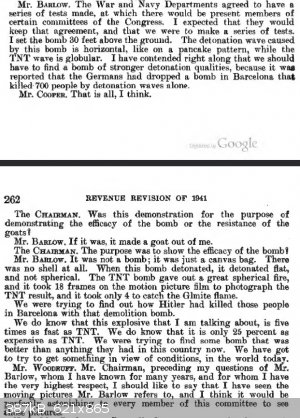
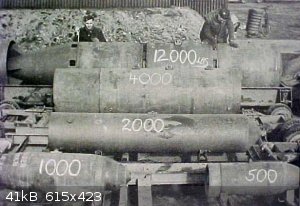
|
|
|
Sir_Gawain
Hazard to Others
  
Posts: 273
Registered: 12-10-2022
Location: Due South of Due West
Member Is Offline
Mood: Yes.
|
|
Five times as fast as TNT? That’s 34,500 m/s!
“Alchemy is trying to turn things yellow; chemistry is trying to avoid things turning yellow.” -Tom deP.
|
|
|
Trashcanman
Harmless

Posts: 20
Registered: 23-1-2024
Member Is Offline
|
|
I seriously doubt it.
I think the method used during the test to determine the detonation velocity of GLMITE was simply unusable.
Even Octanitrocubane only has a detonation velocity of around 10100 m/s.
|
|
|
Sir_Gawain
Hazard to Others
  
Posts: 273
Registered: 12-10-2022
Location: Due South of Due West
Member Is Offline
Mood: Yes.
|
|
Yeah, it’s undoubtedly completely made up. Also, his claim that it detonates “flat” as opposed to spherical makes no sense.
“Alchemy is trying to turn things yellow; chemistry is trying to avoid things turning yellow.” -Tom deP.
|
|
|
Trashcanman
Harmless

Posts: 20
Registered: 23-1-2024
Member Is Offline
|
|
Quote: Originally posted by Sir_Gawain  | | Yeah, it’s undoubtedly completely made up. Also, his claim that it detonates “flat” as opposed to spherical makes no sense.
|
I am not sure what he meant by the bomb detonating "flat" but I guess that he could have meant that the fireball wasn't spherical.
In the attached slow motion footage of a different explosion(not related to GLMITE or this topic in general) you can see that the fireball doesn't
really expand like a sphere. At least not in the first frames.
It is possible that similar slow-mo footage was recorded during the GLMITE test that looked like in the attached mp4 file.
If such footage did exist then it has probably been lost to time. An infrared camera was also used to record the test but I have no idea if that
recording still exists or if it can also be considered lost media.
There is one thing about Barlow that I think I should point out.
He already designed bombs during WW1 and so I believe that he should have had a lot of experience with explosives and that his statements weren't
competely full of BS.
Attachment: NonsphericalFireball.mp4 (247kB)
This file has been downloaded 42 times
|
|
|
Sir_Gawain
Hazard to Others
  
Posts: 273
Registered: 12-10-2022
Location: Due South of Due West
Member Is Offline
Mood: Yes.
|
|
I wonder if it acting almost like a thermobaric bomb threw off some of the tests.
“Alchemy is trying to turn things yellow; chemistry is trying to avoid things turning yellow.” -Tom deP.
|
|
|
Trashcanman
Harmless

Posts: 20
Registered: 23-1-2024
Member Is Offline
|
|
In my opinion there is a chance that at least one of Barlows first small tests with GLMITE could have benefited from a "thermobaric effect" without
him realizing it.
The first tests of fuel air explosive and thermobaric weapons(that I am aware of) were conducted in 1944/45(if you don't include the
Taifun-Gerät which was already tested in 1940) in Germany(annexed Austria) under supervision of Mario Zippermayr.
That means that no scientific publications on thermobaric weaponry could have existed in the US at the time when Barlow claimed in 1940 that GLMITE
would be far more powerful than other explosives.
What was publicly known at the time was that coal dust(mainly consisting of carbon) could lead to severe explosions in the coal
mining industry.
What if exactly that knowledge coupled with a lack of scientific data on coal dust explosions could have lead him to believe that coal/carbon had some
mysterious property which made it very suitable for explosive purposes. This could have motivated Barlow to start experimenting with carbon as a main
ingredient.
I can see how small experiments with a carbon-liquid oxygen mix could have lead to unexpected behaviour during the explosion and I think the key to
this could be the liquid oxygen and its property of evaporating at room temperature.
The problem that the liquid oxygen was evaporating appears to have been a constant problem during the tests.
This can be seen in the attached video before detonation.
Attachment: EvaporatingLiquidOxygen.mp4 (198kB)
This file has been downloaded 34 times
An earlier test even had to be rescheduled because too much liquid oxygen had evaporated.
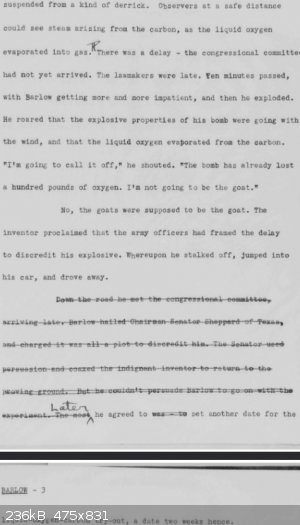
I made a simple image in Paint to better explain how the evaporated oxygen could have contributed to unexpected blast results.
[1]Liquid oxygen has evaporated and because oxygen is heavier than air it has accumulated near ground level and the bomb still
contains liquid oxygen but not enough to oxidize all of the carbon.
[2]The bomb has been triggered and the unreacted carbon dispersed into the vicinity which is filled with more oxygen than would be
normal because the evaporated oxygen has mixed with the air.
[3]The fireball grows to the dimensions of the carbon-(oxygenRich)air cloud and within it the overpressure of the
explosion does not significantly decrease because the detonation reaction propagates throughout this cloud. Thereby the blast wave does not decay as
fast with distance when compared to one caused by an ordinary high explosive.
In other words the evaporated oxygen increases the probability of the unreacted carbon forming an explosive mix in the air and this causes an
unintentional volumetric explosion.

This is of course just a hypothesis but it could explain the result of a different test that is visible in the following picture.
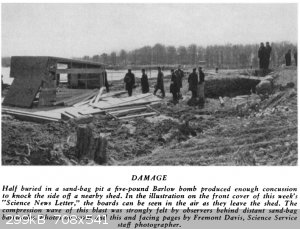
|
|
|